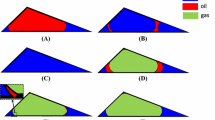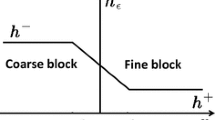Abstract
A computer-aided simulator of immiscible displacement in strongly water-wet consolidated porous media that takes into account the effects of the wetting films is developed. The porous medium is modeled as a three-dimensional network of randomly sized unit cells of the constricted-tube type. Precursor wetting films are assumed to advance through the microroughness of the pore walls. Two types of pore wall microroughness are considered. In the first type of microroughness, the film advances quickly, driven by capillary pressure. In the second type, the meniscus moves relatively slowly, driven by local bulk pressure differences. In the latter case, the wetting film often forms a collar that squeezes the thread of oil causing oil disconnection. Each pore is assumed to have either one of the aforementioned microroughness types, or both. The type of microroughness in each pore is assigned randomly. The simulator is used to predict the residual oil saturation as a function of the pertinent parameters (capillary number, viscosity ratio, fraction of pores with each type of wall microroughness). These results are compared with those obtained in the absence of wetting films. It is found that wetting films cause substantial increase of the residual oil saturation. Furthermore, the action of the wetting films causes an increase of the mean volume of the residual oil ganglia.
Similar content being viewed by others
References
Anderson, W. G.: 1986, Wettability literature survey-Part 1: Rock/oil/brine interactions and the effects of core handling on wettability, J. Petr. Tech. 38, 1125-1144.
Avraam, D. G. and Payatakes, A. C.: 1995, Flow regimes and relative permeabilities during steadystate two-phase flow in porous media, J. Fluid Mech. 293, 207-236.
Blunt, M. J. and Scher, H.: 1995, Pore-level modeling of wetting, Phys. Rev. E 52, 6387-6403.
Celia, M. A., Reeves, P. C. and Ferrand, L. A.: 1995, Recent advances in pore scale models for multiphase flow in porous media, Rev. Geophys. 33,Supplement (also available at earth.agu.org/revgeophys/celia01/celia01.html).
Constantinides, G. N. and Payatakes, A. C.: 1989, A three dimensional network model for consolidated porous media. Basic studies, Chem. Engng Comm. 81, 55-81.
Constantinides, G. N., and Payatakes, A. C.: 1991, A theoretical model of collision and coalescence of ganglia in porous media, J. Colloid Interface Sci. 141, 486-504.
Constantinides, G. N. and Payatakes, A. C.: 1996, Network simulation of steady-state two-phase flow in consolidated porous media, AIChE J. 42, 369-382.
Dias, M. M. and Payatakes, A. C.: 1986a, Network models for two-phase flow in porous media. Part 1. Immiscible microdisplacement of non-wetting fluids, J. Fluid Mech. 164, 305-336.
Dias, M. M. and Payatakes, A. C.: 1986b, Network models for two-phase flow in porous media. Part 2. Motion of oil ganglia, J. Fluid Mech. 164, 337-358.
Dullien, F. A. L. and Dhawan, G. K.: 1975, Bivariate pore-size distribution of some sandstones, J. Colloid Interface Sci. 52, 129-135.
Hammond, P. S.: 1983, Nonlinear adjustment of a thin annular film of viscous fluid surrounding a thread of another within a circular cylindrical pipe, J. Fluid Mech. 137, 363-384.
Homsy, G. M.: 1987, Viscous fingering in porous media, Ann. Rev. Fluid Mech. 19, 271-311.
Kovscek, A. R. and Radke, C. J.: 1996, Gas bubble snap-off under pressure driven flow in constricted non-circular capillaries, Colloids and Surfaces A 117, 55-76.
Legait, B.: 1983, Laminar flow of two-phases through a capillary tube with variable square cross section, J. Colloid Interface Sci. 96, 28-38.
Lenormand, R., Touboul, E. and Zarcone, C.: 1988, Numerical models and experiments on immiscible displacement in porous media, J. Fluid Mech. 189, 165-187.
Lenormand, R., Zarcone, C. and Sarr, A.: 1983, Mechanisms of displacement of one fluid by another in a network of capillary ducts, J. Fluid Mech. 135, 337-353.
Li, Y. and Wardlaw, N. C.: 1986, The influence of wettability and critical pore-throat size ratio on snap-off, J. Colloid Interface Sci. 109, 461-472.
Newhouse, L. A. and Pozrikidis, C.: 1992, The capillary instability of annular layers and liquid threads, J. Fluid Mech. 242, 193-209.
Payatakes, A. C. and Dias, M. M.: 1984, Immiscible microdisplacement and ganglion dynamics in porous media, Rev. Chem. Engng 2, 85-174.
Ransohoff, T. C., Gauglitz, P. A. and Radke, C. J.: 1987, Snap-off of gas bubbles in smoothly constricted noncircular capillaries, AIChE J. 33, 753-765.
Rossen, W. R. and Gauglitz, P. A.: 1990, Percolation theory and mobilization of foams in porous media, AIChE J. 37, 1176-1188.
Sahimi, M.: 1993, Flow phenomena in rocks: From continuum models to fractals, percolation, cellular automata and simulated annealing, Rev. Mod. Phys. 65, 1393-1534.
Tzimas, G. C.: 1997, private communication.
Tzimas, G. C., Matsuura, T., Avraam, D. G., van der Brugghen, W., Constantinides, G. N. and Payatakes, A. C.: 1997, The combined effect of the viscosity ratio and the wettability during forced imbibition through nonplanar porous media, J. Colloid Interface Sci. 189, 27-36.
Vizika, O., Avraam, D. G. and Payatakes, A. C.: 1994, On the role of the viscosity ratio during low-capillary-number forced imbibition in porous media, J. Colloid Interface Sci. 165, 386-401.
Vizika, O. and Payatakes A C.: 1988, Theoretical modeling of the role of the advancing wetting film in the disconnection of the nonwetting fluid during immiscible displacement, 1988 AIChE Annual Meeting, Washington DC (available upon request).
Vizika, O. and Payatakes, A. C.: 1989, Parametric experimental study of forced imbibition in porous media, PhysicoChem. Hydrodynamics 11, 187-204.
Vrij, A. and Overbeek, J. T. G.: 1968, Rupture of thin liquid films due to spontaneous fluctuations in thickness, J. Am. Chem. Soc. 90, 3074-3078.
Wong, H., Morris, S. and Radke, C. J.: 1992a, Two-dimensional menisci in non-axisymmetric capillaries, J. Colloid Interface Sci. 148, 284-287.
Wong, H., Morris, S. and Radke, C. J.: 1992b, Three-dimensional menisci in polygonal capillaries, J. Colloid Interface Sci. 148, 317-336.
Wong, H., Radke, C. J. and Morris, S.: 1995a, The motion of long bubbles in polygonal capillaries: I. Thin films, J. Fluid Mech. 292, 71-95.
Wong, H., Radke, C. J. and Morris, S.: 1995b, The motion of long bubbles in polygonal capillaries: II. Drag, fluid pressure and fluid flow, J. Fluid Mech. 292, 95-110.
Author information
Authors and Affiliations
Rights and permissions
About this article
Cite this article
Constantinides, G.N., Payatakes, A.C. Effects of Precursor Wetting Films in Immiscible Displacement Through Porous Media. Transport in Porous Media 38, 291–317 (2000). https://doi.org/10.1023/A:1006557114996
Issue Date:
DOI: https://doi.org/10.1023/A:1006557114996




